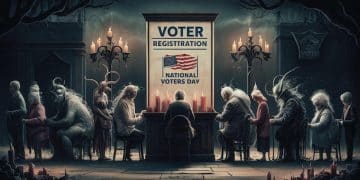Understanding the Electoral College: How It Works and Its Relevance

The Electoral College is a system established by the U.S. Constitution for electing the president and vice president, where instead of directly voting for a candidate, citizens vote for a slate of electors who then cast the actual votes for president. It remains in use due to historical reasons, constitutional design, and perceived benefits in representing diverse populations.
The Electoral College is a cornerstone of the American presidential election process, yet it often sparks confusion and debate. Understanding how this system works and why it persists is crucial for anyone seeking to grasp the intricacies of U.S. politics. Let’s delve into the mechanics and rationale behind this unique institution.
What is the Electoral College?
The Electoral College isn’t a place you can visit, but rather a process defined by the U.S. Constitution. It’s how we elect the president and vice president. Instead of directly voting for a candidate, Americans vote for a slate of electors, who then cast the actual votes that determine the election’s outcome.
Historical Context
The Electoral College was created during the Constitutional Convention of 1787. The Founding Fathers grappled with whether the president should be elected by a popular vote or by Congress. They saw potential issues with both options, leading to a compromise: the Electoral College.
Constitutional Basis
Article II, Section 1 of the U.S. Constitution outlines the Electoral College. Each state is allocated a number of electors equal to its total number of representatives in Congress (House + Senate). The 23rd Amendment grants Washington, D.C., electors as if it were a state, but no more than the least populous state.

In essence, the Electoral College was designed to balance the power between densely populated states and those with smaller populations. It was also intended to serve as a check on direct democracy, providing a layer of deliberation between the popular vote and the election of the president.
The creation of the Electoral College was also influenced by concerns about popular knowledge and regional biases. With limited communication and education, the founders worried that direct democracy might lead to poor choices or favor candidates with only regional appeal.
- Representation: Balances power between states of different sizes.
- Compromise: Resolved debates between direct vote and congressional election.
- Deliberation: Provides a check on pure popular vote.
The Electoral College serves as a method for determining the outcome of presidential elections that is based upon historical context and constitutional design.
How Does the Electoral College Work?
Understanding the mechanics of the Electoral College involves several steps, from allocating electoral votes to the final certification of the election results. It’s a process that unfolds over several weeks following Election Day.
Allocation of Electoral Votes
Each state receives a number of electoral votes equal to its total representation in Congress: the number of House representatives plus its two senators. For example, California has 52 representatives and two senators, giving it 54 electoral votes. The District of Columbia gets three electoral votes due to the 23rd Amendment.
The Winner-Takes-All System
In most states, the candidate who wins the popular vote receives all of that state’s electoral votes. This is known as the “winner-takes-all” system. Maine and Nebraska are exceptions; they use a proportional system, awarding electoral votes based on the popular vote within each congressional district.
Electors and Their Role
Electors are chosen by each state’s political parties. These individuals pledge to support their party’s nominee. While electors are expected to vote for their pledged candidate, there have been instances of “faithless electors” who vote against the popular vote. However, such instances are rare and seldom affect the election outcome.

The Electoral College system is deeply rooted in American political history, influenced by compromises made during the Constitutional Convention and ongoing debates about representation and the balance of power between states.
Understanding the Electoral College is crucial for any citizen who wants to comprehend the election system and how it affects the election results and the president that is elected. It is designed to ensure that all states are represented and that there is a good level of representation from all areas.
- State Representation: Each state receives votes based on its congressional delegation.
- Winner-Takes-All: Most states award all electoral votes to the popular vote winner.
- Electors: Individuals chosen to represent their party and cast electoral votes.
Understanding the mechanics of electoral votes, winner-takes all system, and the role that electors play is crucial to understanding how the electoral college functions.
Arguments in Favor of the Electoral College
Defenders of the Electoral College maintain that it protects the interests of less populated states and ensures that a candidate must build broad support across different regions, rather than focusing solely on densely populated areas.
Protecting Small States
One of the primary arguments in favor of the Electoral College is that it prevents candidates from winning the presidency by focusing only on populous states. Without the Electoral College, a few large states could potentially decide the election, ignoring the concerns and interests of smaller states.
Promoting National Unity
Because candidates need to campaign and win support in multiple states, the Electoral College arguably encourages national unity. To win the presidency, candidates must appeal to a diverse range of voters across different regions, fostering a sense of shared purpose and national identity.
Ensuring Legitimacy
The Electoral College can provide a clear and decisive outcome, even in closely contested elections. In situations where the popular vote is split, the Electoral College may offer a more legitimate result by requiring a broader base of support.
Another argument in favor of the Electoral College is that it offers protections against potential voter fraud. Because the election results are ultimately determined by the electoral vote, it is harder to defraud the election.
The Electoral College also forces candidates to learn about the needs of the different states and regions. This promotes unity and ensures the states’ needs are recognized. This is important as the interests of various regions do not always intersect.
- Equal Representation: Every state has a voice in the election.
- Campaigning: Candidates must learn about and visit all regions of the US.
- Broader Support: Candidates can’t win by only focusing on populous states.
Many people defend the Electoral College due to its benefits in representing the needs of all states, providing fair and equal representation.
Criticisms of the Electoral College
Despite its merits, the Electoral College faces criticism for potentially undermining the popular vote and creating scenarios where the candidate with fewer individual votes wins the presidency.
Discrepancy with the Popular Vote
One of the most significant criticisms is that the Electoral College can lead to a president being elected without winning the popular vote. This has happened in several U.S. presidential elections, most recently in 2000 and 2016, leading to questions about the fairness and legitimacy of the system.
Focus on Swing States
The winner-takes-all approach often causes candidates to concentrate their resources and attention on a few swing states, effectively ignoring the needs and concerns of voters in states considered safe for one party or the other. This can lead to unequal representation and disenfranchisement.
Depressed Voter Turnout
In states where the outcome is perceived as predetermined, voter turnout may be lower. Voters may feel that their individual votes don’t matter, reducing participation in the democratic process.
Those who criticize the Electoral College often highlight that it runs contrary to the democratic ideal of “one person, one vote.” They propose alternative systems, such as the National Popular Vote Interstate Compact, which aims to award electoral votes to the candidate who wins the national popular vote.
The current system often creates confusion in regards to outcomes as a candidate can win the popular vote, but lose the election. This leaves many questioning not only the legitimacy of the election, but also the results.
- Undermines Popular Vote: Can lead to a president elected without the majority of individual votes.
- Unequal Representation: Focus on swing states neglects other voters.
- Voter Turnout: Can depress turnout in states where the outcome is perceived as predetermined.
Despite its merits, the Electoral College also faces criticism for potentially undermining the popular vote when the candidate with less popular votes wins the presidential race.
Historical Examples of Electoral College Controversies
Several U.S. presidential elections have highlighted the controversial nature of the Electoral College, with outcomes that sparked intense debate and calls for reform.
1876: Hayes vs. Tilden
The 1876 election between Rutherford B. Hayes and Samuel Tilden was one of the most disputed in U.S. history. Tilden won the popular vote, but the Electoral College outcome was uncertain due to disputed votes in several states. A special Electoral Commission ultimately awarded the presidency to Hayes.
2000: Bush vs. Gore
In 2000, George W. Bush won the presidency despite Al Gore winning the popular vote by over 500,000 votes. The election hinged on Florida, where a recount was ordered. The Supreme Court ultimately halted the recount, effectively awarding Florida’s electoral votes and the presidency to Bush.
2016: Trump vs. Clinton
Donald Trump won the 2016 election despite Hillary Clinton winning the popular vote by nearly three million votes. This outcome led to widespread protests and renewed calls for abolishing the Electoral College.
These elections underscore the potential for the Electoral College to produce results that diverge from the popular vote, leading to questions about the fairness and representative nature of the system.
These examples underscore how the Electoral College has given rise to controversy. Some of the concerns are based around legitimate concerns, while others are simply disgruntled that their candidate did not win the election.
- Hayes vs. Tilden: Awarded the presidency to Hayes despite Tilden winning the popular vote.
- Bush vs. Gore: The Supreme Court halted a recount of Florida due to disputed votes.
- Trump vs. Clinton: Sparked debates about the role of the Electoral College.
Several U.S. presidential elections have highlighted the controversial nature of the Electoral College, with outcomes that sparked intense debate and calls for reform through different times in history.
Potential Reforms and the Future of the Electoral College
Given the ongoing debate, various reforms to the Electoral College have been proposed, ranging from abolishment to modifications that aim to align the electoral vote more closely with the popular vote.
Abolishing the Electoral College
One of the most radical reforms proposed is to abolish the Electoral College altogether, replacing it with a national popular vote. This would require a constitutional amendment, which is a difficult and complex process. Supporters argue that it would ensure that the person with the most votes becomes president, aligning the system with democratic principles.
National Popular Vote Interstate Compact
The National Popular Vote Interstate Compact (NPVIC) is an agreement among states to award their electoral votes to the candidate who wins the national popular vote. The compact would go into effect when states with a majority of electoral votes (270) join the agreement. This approach seeks to achieve a national popular vote without amending the Constitution.
Proportional Allocation of Electoral Votes
Another proposed reform is to allocate electoral votes proportionally based on the popular vote within each state. This would eliminate the winner-takes-all system and could potentially lead to more competitive elections and broader representation.
The future of the Electoral College remains uncertain, with ongoing legal challenges, political debates, and advocacy efforts pushing for various reforms. Any significant change would likely require substantial political will and consensus.
The reform efforts that have been made so far have been attempts to correct the issues that have plagued the electoral system throughout history. Whether or not the system changes, or remains in place is highly dependent on the political will of the people and the government.
- Abolishing: Changing the method to reflect the national popular vote, creating a true democracy.
- NPVIC: Seeks to award electoral votes to the national popular vote winner without amending the Constitution.
- Proportional Allocation: Allocating electoral votes based on the popular vote within each state.
Given the ongoing debate, various reforms to the Electoral College have been proposed, ranging from abolishment to modifications that aim to align the electoral vote with the popular vote.
| Key Concept | Brief Description |
|---|---|
| 🗳️ Electoral College | System where electors, not popular vote, determine the U.S. president. |
| ⚖️ State Power | Balances power between populous and less populous states in presidential elections. |
| 📜 Constitution | Established during the Constitutional Convention to compromise between popular and congressional election. |
| 🔄 Reforming | Current proposals aim to align electoral votes more closely with national popular vote results. |
Frequently Asked Questions
▼
Each state receives a number of electoral votes equal to its total number of representatives in Congress (House + Senate). The District of Columbia gets three electoral votes due to the 23rd Amendment, ensuring it has some representation.
▼
If no candidate wins a majority (270) of electoral votes, the House of Representatives chooses the president from the top three candidates. Each state gets one vote in this process, ensuring equal representation.
▼
Yes, an elector can vote against the popular vote, becoming a “faithless elector.” While rare, some states have laws to prevent this, and penalties may apply, but these votes are seldom decisive in an election.
▼
The NPVIC is an agreement among states to award their electoral votes to the candidate who wins the national popular vote. It goes into effect when states with a majority of electoral votes (270) join the agreement.
▼
The Electoral College was created during the Constitutional Convention to compromise between a popular vote and congressional election. It aimed to balance power between populous and less populous states, ensuring fair representation for all.
Conclusion
The Electoral College remains a central, albeit controversial, part of the U.S. presidential election process. Understanding its mechanics, historical context, and ongoing debates is essential for informed participation in American democracy.





